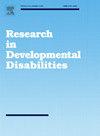Motor and visuospatial processing profile in a cross-conditions study: A comparison between developmental coordination disorder and nonverbal learning disability
IF 2.9
2区 医学
Q1 EDUCATION, SPECIAL
引用次数: 0
Abstract
Background
Neurodevelopmental conditions often exhibit overlapping symptoms, posing challenges for differential diagnosis. Developmental Coordination Disorder (DCD) manifests as fundamental motor impairments, often along with co-occurring visuospatial difficulties. Nonverbal Learning Disorder (NLD) features visuospatial core challenges, with a less consistent characterization of its motor profile. Strikingly, to date no study has directly compared DCD and NLD profiles.
Aims
The present study aimed to analyze whether DCD and NLD share any characteristics by contrasting their motor and visuospatial performances, comparing them with non-diagnosed (ND) peers.
Methods and Procedures
A total of 102 participants (8–16 years; DCD N = 29, NLD N = 29, ND N = 44) completed motor and visuospatial tasks. The groups' performance was compared, and the discriminatory power of the measures administered was analyzed.
Outcomes and Results
Our findings support the substantial motor and visuospatial impairments in DCD and NLD, respectively. Regarding diagnostic efficacy, motor and visuospatial tasks effectively differentiated DCD or NLD from ND, with specificities related to each condition. Balance, and to a lesser extent, Spatial Processing revealed significant predictive power in distinguishing between DCD and NLD.
Conclusions and Implications
Our results revealed cross-disorder similarities and highlighted specific hallmarks, corroborating the need of a comprehensive motor and visuospatial assessment for distinguishing between DCD and NLD.
跨条件研究中的运动和视觉空间加工特征:发展性协调障碍和非语言学习障碍的比较。
背景:神经发育疾病经常表现出重叠的症状,对鉴别诊断提出了挑战。发育性协调障碍(DCD)表现为基本的运动障碍,通常伴有视觉空间障碍。非语言学习障碍(NLD)以视觉空间核心挑战为特征,其运动特征不太一致。引人注目的是,迄今为止还没有研究直接比较DCD和NLD的概况。目的:本研究旨在通过对比DCD和NLD患者的运动和视觉空间表现,并将其与未确诊的ND患者进行比较,分析他们是否有共同的特征。方法和程序:共102名受试者(8-16岁;DCD N = 29,NLD N = 29,ND N = 44)完成运动和视觉空间任务。比较各组的表现,并分析所采取措施的歧视性力量。结果和结果:我们的研究结果分别支持DCD和NLD患者存在大量的运动和视觉空间障碍。在诊断效能方面,运动和视觉空间任务可以有效地将DCD或NLD与ND区分开来,并具有与每种疾病相关的特异性。在较小程度上,空间处理在区分DCD和NLD方面显示出显著的预测能力。结论和意义:我们的研究结果揭示了交叉障碍的相似性,并强调了特定的特征,证实了需要进行全面的运动和视觉空间评估来区分DCD和NLD。
本文章由计算机程序翻译,如有差异,请以英文原文为准。
求助全文
约1分钟内获得全文
求助全文
来源期刊

Research in Developmental Disabilities
Multiple-
CiteScore
5.50
自引率
6.50%
发文量
178
期刊介绍:
Research In Developmental Disabilities is aimed at publishing original research of an interdisciplinary nature that has a direct bearing on the remediation of problems associated with developmental disabilities. Manuscripts will be solicited throughout the world. Articles will be primarily empirical studies, although an occasional position paper or review will be accepted. The aim of the journal will be to publish articles on all aspects of research with the developmentally disabled, with any methodologically sound approach being acceptable.
 求助内容:
求助内容: 应助结果提醒方式:
应助结果提醒方式:


